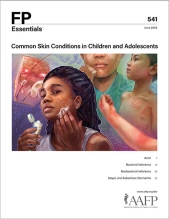
Common Skin Conditions in Children and Adolescents
SECTION TWO
Bacterial Infections
This clinical content conforms to AAFP criteria for CME.
Bacterial skin infections represent a significant health care burden. Cellulitis and erysipelas are rapidly spreading, painful, superficial skin infections, usually caused by streptococci or Staphylococcus aureus. Folliculitis is an infection of hair follicles mostly caused by S aureus. Simple folliculitis typically is self-limited. Topical benzoyl peroxide is a first-line nonantibiotic treatment. Mupirocin and clindamycin are topical antibiotic options. For treatment-resistant cases, oral cephalexin or dicloxacillin is an appropriate option. Impetigo is a common, self-limited infection in children. Bullous impetigo is caused by S aureus, and nonbullous impetigo is caused by beta-hemolytic streptococci, S aureus, or both. In most cases, topical mupirocin or retapamulin (Altabax) is effective. Oral antibiotics should be considered for household outbreaks or patients with multiple lesions. Abscesses are red, painful collections of purulence in the dermis and deeper tissues caused by S aureus or polymicrobial infections. Furuncles are abscesses of a hair follicle, whereas carbuncles involve several hair follicles. In recurrent cases of these lesions, culture of the exudate is recommended. Abscess, furuncle, and carbuncle management consists of incision and drainage. Oral antibiotics are not necessary in most cases but should be prescribed for patients with severe immunocompromise or systemic signs of infection. In bacterial skin infections, methicillin-resistant S aureus coverage should be considered for patients with infections that have not improved with treatment.
Subscribe
From $350- Immediate, unlimited access to FP Essentials content
- 60 CME credits/year
- AAFP app access
- Print delivery available
Edition Access
$44- Immediate, unlimited access to this edition's content
- 5 CME credits
- AAFP app access
- Print delivery available

